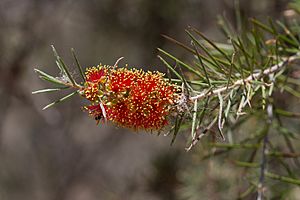Prickly bottlebrush facts for kids
Quick facts for kids Prickly bottlebrush |
|
|---|---|
 |
|
| Melaleuca brachyandra growing in Morgan | |
| Scientific classification | |
| Genus: |
Melaleuca
|
| Species: |
brachyandra
|
| Synonyms | |
|
|
The Prickly Bottlebrush, also known as Scarlet Bottlebrush, is a cool plant from the myrtle family. Its scientific name is Melaleuca brachyandra. This plant is special because it only grows naturally in certain parts of Australia, like New South Wales, Victoria, and South Australia. When a plant or animal only lives in one specific area, we say it is endemic to that place.
This plant is usually a shrub, but it can also grow into a small tree. It has thin leaves and bright red and green flowers that look really pretty. Because of its beautiful flowers, people often plant it in their gardens, especially in places with mild weather.
Contents
What Does the Prickly Bottlebrush Look Like?
The Prickly Bottlebrush is a shrub that can grow from about 1.5 m (4.9 ft) to 8 m (26 ft) tall. It has tough bark and a strong, upright shape.
Leaves of the Bottlebrush
Its leaves grow one after another along the stem. They are long and narrow, usually about 18 mm (0.71 in) to 61 mm (2.4 in) long and very thin, only about 0.5 mm (0.020 in) to 1.7 mm (0.067 in) wide. The leaves are shaped like a line and have a sharp point at the end.
Flowers and Fruits of the Bottlebrush
The flowers of the Prickly Bottlebrush grow in spikes, like a bottle brush! These spikes are found at the ends of the branches. Even after the flowers bloom, the branches keep growing. Each flower spike can be up to 35 mm (1.4 in) wide and have anywhere from 7 to 36 individual flowers.
Each flower has small petals, about 2.8 mm (0.11 in) to 4.9 mm (0.19 in) long, which fall off as the flower gets older. The most striking part of the flower is its many stamens, which are the parts that hold pollen. There are usually 50 to 84 stamens in each flower. Their "stalks" are a bright crimson red, and their "tips" (called anthers) are green.
The Prickly Bottlebrush usually flowers from September to January. After the flowers fade, they turn into woody seed pods, called capsules. These capsules are about 9 mm (0.35 in) to 12.4 mm (0.49 in) long.
How Was the Prickly Bottlebrush Named?
The scientific name Melaleuca brachyandra was officially given to this plant in 2006 by a scientist named Lyndley Craven. Before that, it was known as Callistemon brachyandrus. That name was first used by John Lindley in 1849.
The second part of its scientific name, brachyandra, comes from two ancient Greek words: brachys, which means "short," and anēr (or andros), which means "male." This name refers to the stamens (the "male" parts of the flower) being shorter than another part of the flower called the style.
Today, many scientists, including those at the Royal Botanic Gardens, Kew, consider Callistemon brachyandrus to be the same plant as Melaleuca brachyandra.
Where Does the Prickly Bottlebrush Grow?
You can find the Prickly Bottlebrush scattered in inland areas of New South Wales, especially around the Cobar district. It also grows in the lower Murray River regions of north-western Victoria and south-eastern South Australia.
Growing Prickly Bottlebrush in Your Garden
Even though its leaves can be a bit prickly, the Prickly Bottlebrush is a great plant for gardens because of its beautiful flower spikes. It's often tougher and more resistant to common plant problems than some other bottlebrush types. If you want to grow one, it likes soil that drains well and a spot where it can get plenty of sunshine.

